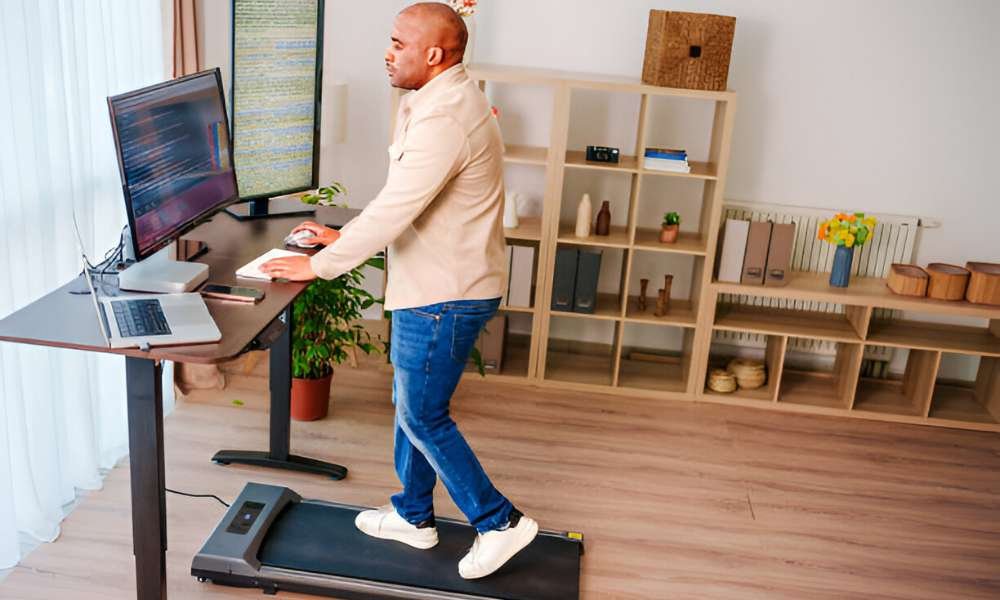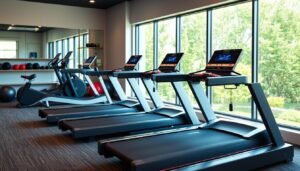Using a treadmill standing desk a day can be an effective way to stay active while working, helping to improve posture, boost energy, and reduce the negative effects of sitting for extended periods. Unlike traditional desks, which promote long hours of sitting, a treadmill desk allows users to walk at a slow pace while completing tasks, encouraging more movement throughout the day. However, it’s important to use it in moderation, as walking for too long or without proper adjustments can lead to fatigue or discomfort. Finding the right balance between walking, standing, and sitting is essential to getting the most out of your treadmill standing desk. This guide will explore how long to use a treadmill standing desk a day and provide tips for a comfortable and productive experience.
Recommended Duration
Beginner: 30–60 Minutes Per Day
If you are new to using a treadmill standing desk, start with 30–60 minutes per day. This allows your body to adjust to walking while working without causing excessive fatigue. Begin at a slow pace, around 1–2 mph, and gradually increase as you become more comfortable. Pay attention to any discomfort and take breaks as needed.
Intermediate: 1–2 Hours Per Day
Once you are accustomed to walking while working, you can increase your usage to 1–2 hours per day. At this stage, alternating between walking, standing, and sitting is key to maintaining good posture and preventing fatigue. Consider breaking up your walking sessions into shorter intervals throughout the day rather than walking for long, continuous periods.
Advanced: 3–4 Hours Per Day
For experienced users, walking for 3–4 hours per day can be beneficial for overall health and productivity. However, it’s essential to listen to your body and avoid overuse. Using a cushioned mat, wearing supportive shoes, and maintaining an ergonomic desk setup can help reduce strain. Additionally, incorporating occasional rest periods and stretching exercises can improve long-term comfort and sustainability.
Factors to Consider
Your personal fitness level and experience with a treadmill desk play a crucial role in determining how long you should use one each day. If you are new to treadmill desks, it is important to start with shorter sessions, around 30 minutes to an hour, to allow your body to adjust. Walking too much too soon can cause fatigue, soreness, or discomfort. Over time, as endurance improves, users can gradually extend their walking duration to two hours or more. Work requirements also impact usage—tasks that require deep concentration, such as writing or coding, may be harder to perform while walking, whereas activities like reading emails or attending meetings can be done easily. Comfort is another important factor, as improper footwear, desk height, or monitor placement can lead to strain and discomfort. It is essential to ensure an ergonomic setup to avoid issues like neck or back pain. Additionally, the type of tasks performed while walking can affect productivity. Simple tasks are easier to manage, while more precise work may require a seated or standing position. By considering these factors, users can create a balanced routine that maximizes both movement and efficiency.
Best Practices for Usage
When starting with a treadmill desk, it is essential to begin slowly and gradually increase usage. Jumping into long periods of walking too quickly can cause discomfort, muscle fatigue, and even joint strain. Beginners should aim for 30-minute sessions at a slow pace, around 1–2 mph, and gradually increase as their body adapts. Maintaining proper posture is also critical for long-term use. The monitor should be at eye level to prevent neck strain, and wrists should remain neutral while typing to avoid repetitive strain injuries. Walking at a steady and slow pace helps maintain balance and reduces unnecessary stress on the body. Wearing comfortable, supportive shoes can further improve posture and prevent foot discomfort. Additionally, alternating between walking, standing, and sitting is the best approach for maintaining comfort and productivity. Walking for extended periods without breaks can cause foot fatigue and muscle strain. A balanced routine, such as walking for an hour, standing for 30 minutes, and sitting for focused work, can help prevent discomfort while keeping the body engaged. Regularly switching positions improves circulation, reduces stiffness, and allows for sustained productivity throughout the day.
Potential Risks & How to Avoid Them
Overuse and fatigue can occur if you walk for too long without breaks, leading to soreness and exhaustion. Beginners should start with short sessions and gradually increase duration. Alternating between walking, standing, and sitting helps prevent strain, while proper footwear and stretching improve comfort.
Joint strain and improper posture can result from poor ergonomics. Looking down at a screen, leaning forward, or using an incorrectly positioned desk can cause discomfort. To avoid this, maintain a neutral spine, keep your monitor at eye level, and walk at a slow pace (1–2 mph) to ensure stability.
Distractions affecting productivity are another risk. While walking can enhance energy and focus, it may make detailed tasks like typing or designing more difficult. To stay productive, use walking time for simpler tasks like emails or meetings and sit for tasks that require precision.
Read more: How to Lubricate A Treadmill
Conclusion
Incorporating a treadmill standing desk into your daily routine can provide significant health benefits, from reducing the risks of prolonged sitting to improving posture and energy levels. However, how long you use a treadmill standing desk a day is key to maximizing its benefits. Start with short walking sessions and gradually increase the duration as your body adjusts. Make sure your workstation is set up ergonomically to avoid strain and discomfort. Alternating between walking, standing, and sitting throughout the day helps prevent fatigue and keeps you productive. By listening to your body and adapting your routine, you can enjoy the benefits of using a treadmill standing desk a day without overdoing it.




